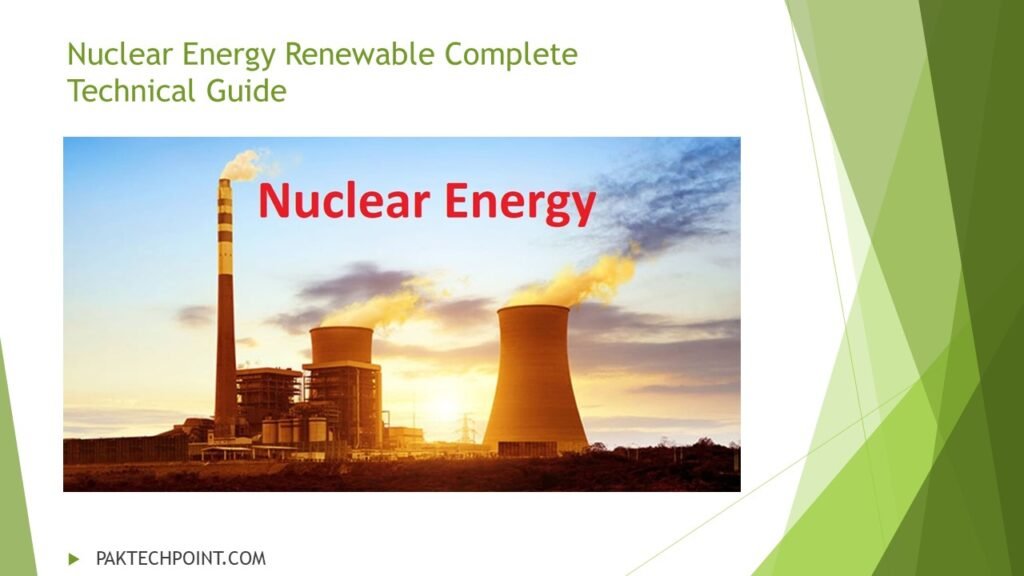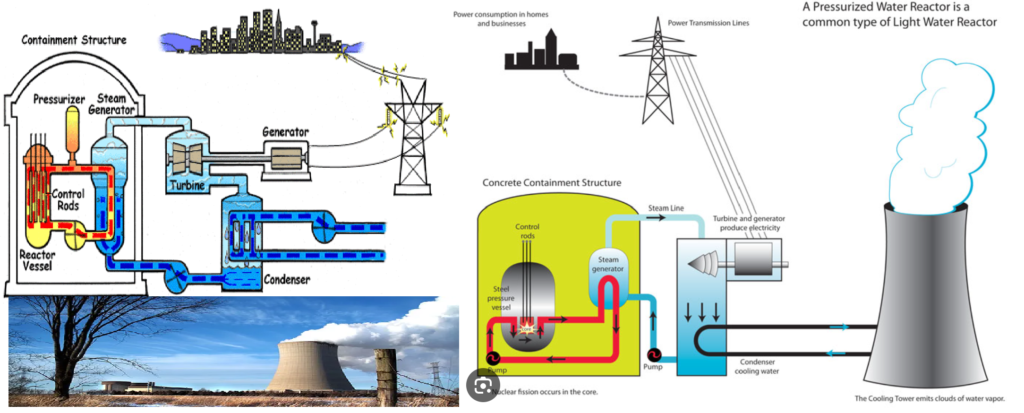Nuclear energy is a topic that often sparks heated discussions within the energy sector and among policymakers and environmentalists. While some argue that nuclear power is a renewable and sustainable energy source, others vehemently oppose this notion, citing concerns about safety, waste management, and potential environmental impacts. In this in-depth analysis, we will explore the various aspects of nuclear energy to determine whether it can truly be classified as renewable and its potential role in a sustainable energy future.

What is Nuclear Energy or Power?
Nuclear energy, also known as nuclear power, is the energy produced from nuclear reactions that occur within the core of atoms. It is a form of energy that is produced by splitting or fusing atomic nuclei. The two primary nuclear processes used for energy generation are nuclear fission and nuclear fusion.
- Nuclear Fission: Nuclear fission is the process of splitting the nucleus of an atom into two smaller nuclei, accompanied by the release of a large amount of energy. This process is used in nuclear power plants to produce electricity. Typically, isotopes of heavy elements, such as uranium-235 or plutonium-239, are used as nuclear fuel in nuclear fission reactors. During fission, a neutron strikes the nucleus of a fuel atom, causing it to split into two smaller atoms, along with the release of additional neutrons and energy. These released neutrons can go on to cause further fission reactions, leading to a self-sustaining chain reaction. The heat generated from nuclear fission is used to produce steam, which drives turbines connected to electricity generators.
- Nuclear Fusion: Nuclear fusion is the process of combining two smaller atomic nuclei to form a larger nucleus, accompanied by the release of a significant amount of energy. This process is the same process that powers the sun and stars. However, achieving controlled nuclear fusion on Earth for practical energy production is still a technological challenge and has not been fully realized as a commercial power source.
Nuclear energy is known for its high energy density, meaning that a small amount of nuclear fuel can produce a large amount of energy. It is considered a low-carbon energy source because nuclear power plants do not emit greenhouse gases during electricity generation. However, nuclear energy does produce radioactive waste, which requires careful management and disposal.
Nuclear energy is used to generate electricity in nuclear power plants, which provide a significant portion of the world’s electricity supply. Despite the challenges and controversies surrounding nuclear energy, it remains an important part of the global energy mix and plays a crucial role in meeting electricity demands while aiming to reduce greenhouse gas emissions and combat climate change.
How is nuclear energy produced?
Nuclear energy is produced through a process called nuclear fission. This process involves the splitting of the nucleus of an atom, typically uranium-235 or plutonium-239, into smaller fragments. When the nucleus of an atom is split, a tremendous amount of heat energy is released.
The process of producing nuclear energy in a nuclear power plant involves the following steps:
- Nuclear Fuel: Nuclear power plants use nuclear fuel, such as uranium or plutonium, as the source of energy. Uranium-235 is the most commonly used fuel in commercial nuclear power plants.
- Nuclear Fission: Inside the nuclear reactor core, nuclear fission occurs when a neutron collides with the nucleus of a uranium-235 atom. This collision causes the uranium nucleus to split into two smaller nuclei and releases two or three additional neutrons, which can further collide with other uranium nuclei, setting off a chain reaction.
- Heat Generation: The energy released during the fission process is in the form of heat. This heat is used to generate steam by heating water in a separate system called the primary coolant loop.
- Steam Generation: The heat from the nuclear reactor is transferred to the water in the primary coolant loop, turning it into high-pressure steam.
- Turbine and Generator: The high-pressure steam is directed to a steam turbine, where it causes the turbine blades to rotate. The rotating turbine is connected to a generator, which converts mechanical energy into electrical energy.
- Electricity Generation: As the turbine spins the generator, electricity is produced in the form of alternating current (AC) electricity.
- Power Distribution: The generated electricity is then transmitted through power lines to homes, businesses, and industries, providing electrical power to the grid.
It’s important to note that nuclear power plants are carefully designed and regulated to ensure safety and prevent any potential release of harmful radiation. Additionally, nuclear power plants produce minimal greenhouse gas emissions during electricity generation, making them an attractive option for countries aiming to reduce their carbon footprint and combat climate change. However, the disposal of nuclear waste and the potential for nuclear accidents remain significant concerns associated with nuclear energy production.

1. Understanding Nuclear Energy
1.1 What is Nuclear Energy?
Nuclear energy is a form of energy that is harnessed from the process of nuclear fission. It involves splitting the nucleus of an atom, typically uranium-235 or plutonium-239, into smaller fragments, releasing a tremendous amount of heat energy in the process. This heat energy is then used to generate steam, which drives turbines connected to electricity generators, producing electricity.
1.2 Nuclear Fuel Cycle
The nuclear fuel cycle involves several stages, including mining and milling of uranium, enrichment, fuel fabrication, reactor operation, spent fuel management, and, ultimately, decommissioning of nuclear power plants. The process requires careful handling of radioactive materials to prevent environmental contamination and potential health hazards.
2. The Case for Nuclear Energy as Renewable
2.1 Continuous Energy Generation
Proponents argue that nuclear energy provides a continuous and reliable power source. Unlike solar and wind, which are intermittent and depend on weather conditions, nuclear power plants can operate 24/7, ensuring a stable electricity supply.
2.2 Low Greenhouse Gas Emissions
Nuclear power plants produce minimal greenhouse gas emissions during electricity generation. This characteristic makes nuclear energy appealing in the context of reducing carbon emissions and mitigating climate change.
2.3 Efficient Energy Conversion
Nuclear power boasts a high energy conversion efficiency, meaning it requires a relatively small amount of uranium to produce substantial amounts of electricity compared to fossil fuels.
3. The Controversy Surrounding Nuclear Energy
3.1 Non-Renewable Uranium Reserves
While nuclear fuel is technically not consumed during the fission process, it is derived from mined uranium ore. Uranium reserves are finite, raising questions about the long-term sustainability of nuclear energy.
3.2 Nuclear Accidents and Safety Concerns
High-profile accidents like Chernobyl and Fukushima have raised serious doubts about the safety of nuclear power plants. The potential for catastrophic incidents and the management of nuclear waste pose significant challenges.
3.3 Nuclear Waste Disposal
One of the most contentious issues is the long-term storage and disposal of radioactive waste generated by nuclear power plants. Finding a safe and secure solution for nuclear waste remains an ongoing challenge.
4. Nuclear Energy and Sustainable Development
4.1 Energy Security and Independence
Nuclear energy can play a role in enhancing energy security and reducing dependence on fossil fuel imports, contributing to the overall sustainability of a nation’s energy supply.
4.2 High Energy Density
The energy density of nuclear fuel is exceptionally high, requiring smaller quantities of fuel compared to other sources for the same energy output. This characteristic is valuable for minimizing resource extraction impacts.
4.3 Potential for Technological Advancements
Advancements in nuclear technology, such as fast breeder reactors and thorium-based reactors, hold promise for addressing current concerns and making nuclear energy more sustainable.
Nuclear Energy – A Complex Dilemma
The question of whether nuclear energy is renewable and sustainable is not easily answered. While nuclear power offers low carbon emissions and consistent energy generation, its potential environmental and safety risks raise significant concerns. The future of nuclear energy relies on further technological innovations, robust safety measures, and effective waste management solutions. Ultimately, striking a balance between energy security and environmental responsibility will shape the role of nuclear power in the pursuit of a sustainable energy future.
Is nuclear energy clean?
Nuclear energy is often considered a clean source of electricity because it does not produce greenhouse gas emissions during its operation. However, the process of mining, enriching, and transporting nuclear fuel does produce some emissions. Additionally, nuclear energy generates radioactive waste, which requires careful management and disposal to minimize environmental impacts. While it has low greenhouse gas emissions during operation, the overall environmental impact and the handling of nuclear waste make the classification of nuclear energy as “clean” a subject of debate.
Nuclear energy advantages and disadvantages
Below is a table listing the advantages and disadvantages of nuclear energy:
| Advantages of Nuclear Energy | Disadvantages of Nuclear Energy |
|---|---|
| Low Greenhouse Gas Emissions | Radioactive Waste Disposal |
| High Energy Density | High Initial Costs |
| Relatively Low Fuel Costs | Potential for Nuclear Accidents |
| Continuous Power Generation | Limited Fuel Supply |
| Base Load Power Source | Long Construction Time |
Read Also: Green Energy What it is? How does it work? Types, Examples – Climate Effect
FAQs about Nuclear Energy:
Is nuclear energy bad for the environment?
However, nuclear energy also has significant environmental concerns. The process of mining, enriching, and transporting uranium for nuclear fuel can have environmental impacts, including habitat disruption and water pollution. Nuclear power plants require a substantial amount of water for cooling, which can have adverse effects on local ecosystems and aquatic life when not managed properly.
The most significant environmental concern with nuclear energy is the generation of radioactive waste, which remains hazardous for thousands of years. The safe and secure disposal of this waste is a complex and challenging issue. Accidents at nuclear power plants, such as the Chernobyl and Fukushima disasters, have also demonstrated the potential for catastrophic environmental consequences.
Overall, the environmental impacts of nuclear energy are a subject of debate, with proponents emphasizing its low greenhouse gas emissions and opponents raising concerns about waste management and potential accidents.